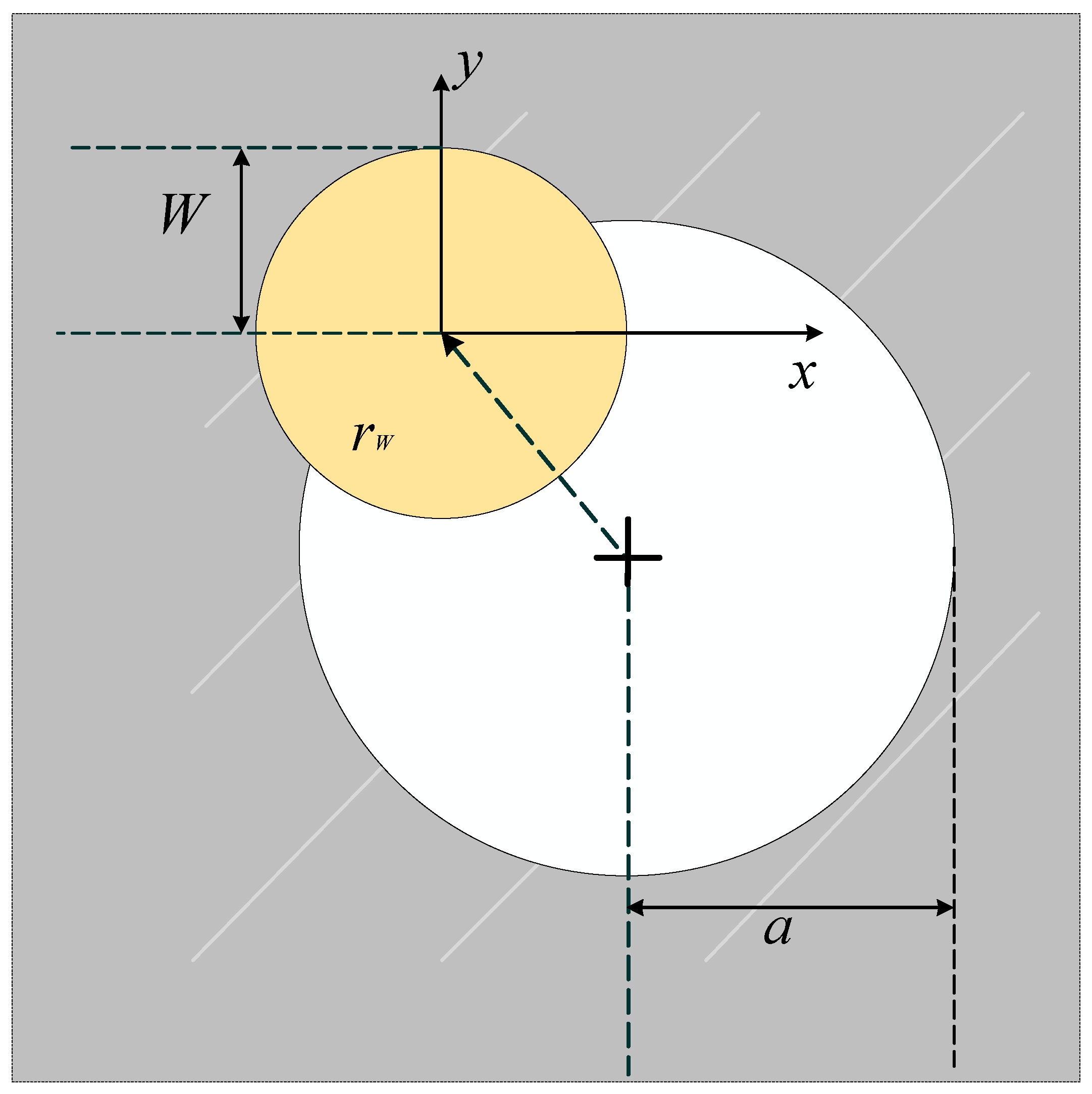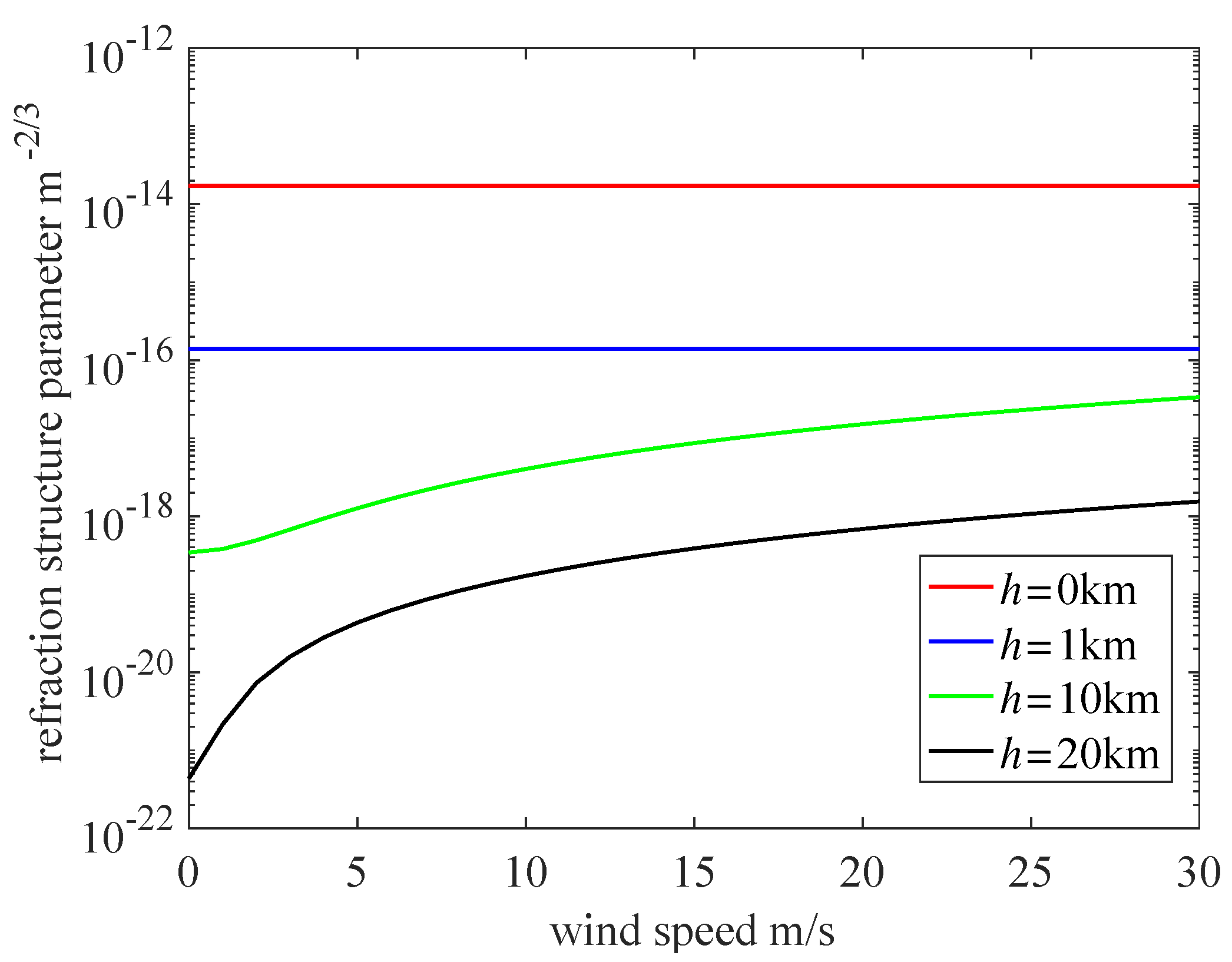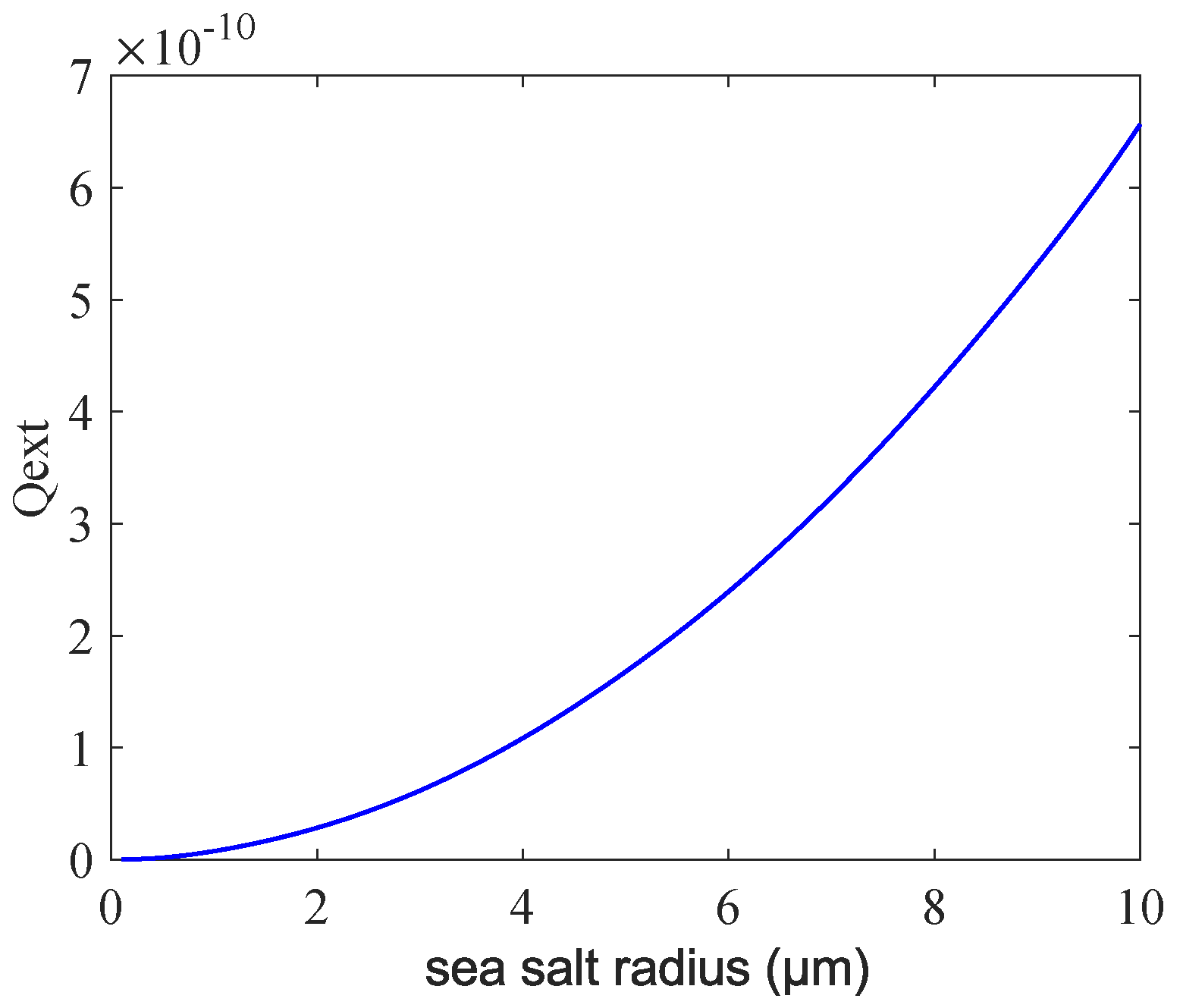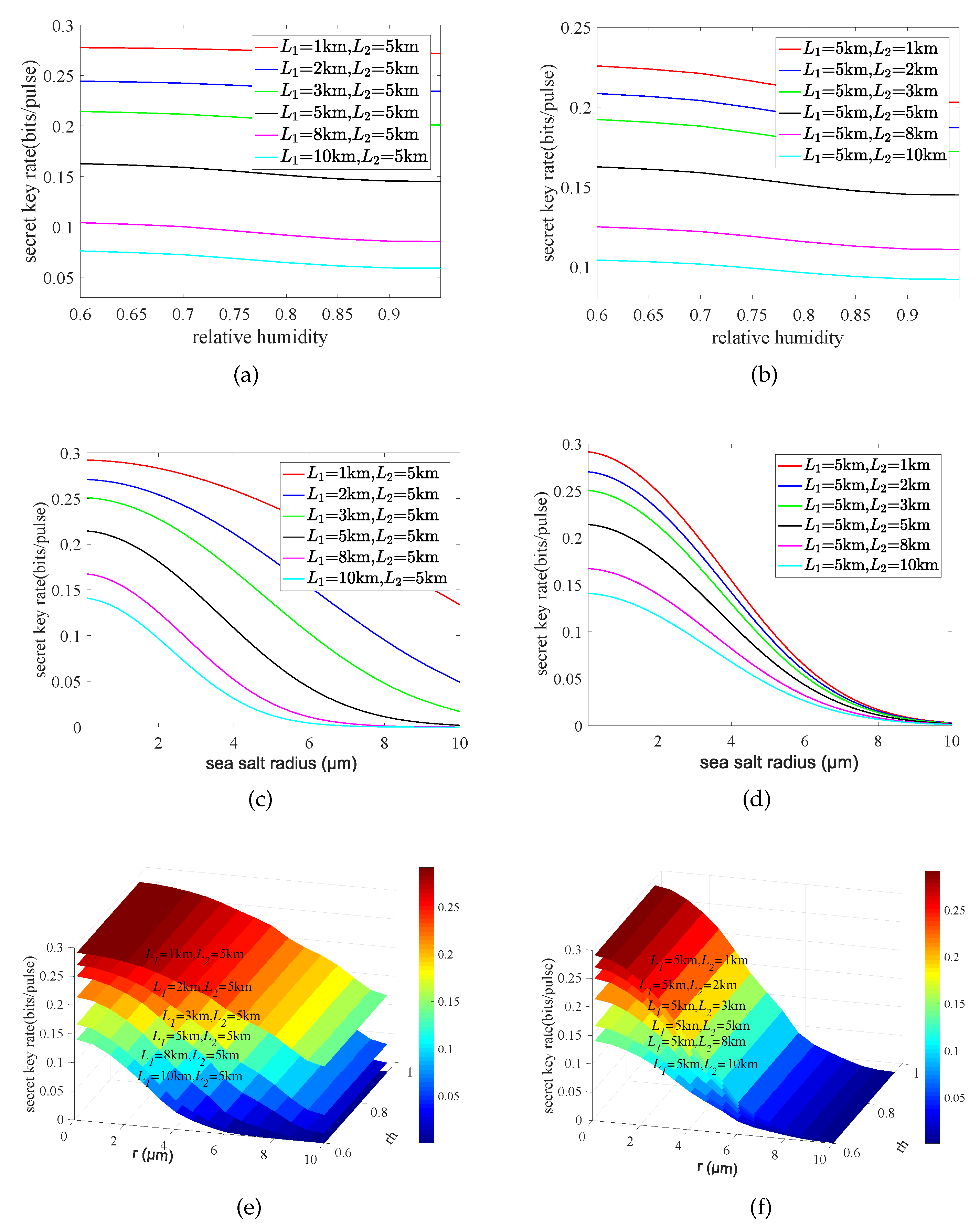1. Introduction
Quantum communication has witnessed rapid development. Quantum key distribution (QKD) [
1,
2] is no longer applicable to minor scales and short distances with favorable ambient conditions. Traditional optical fiber channel QKD [
3,
4] has not yet met the growing demand, hence atmospheric channel QKD [
5,
6,
7] has attracted increasing attention. Compared to optical fiber channel QKD with fixed-attenuation, atmospheric channel QKD could cover a wider range of transmission with more flexible transmission [
8,
9]. For example, it is difficult to apply optical fiber channels for quantum communication on the sea, so atmospheric channels have come into play. However, the environments of atmosphere are relatively complicated, and beam propagation in the atmosphere is inevitably affected by the atmosphere [
10,
11,
12]. The influence of complex atmosphere on beam propagation mainly involves absorption and scattering of beam by atmospheric molecules and aerosols and disturbance of beam by atmospheric turbulent motion. The former mainly leads to the loss of beam energy, with the name of atmospheric attenuation. The latter causes beam wandering deformation and scintillation [
13,
14], commonly referred to as atmospheric turbulence effect.
The influence of complex atmosphere on QKD protocol performance cannot be elided. There is some research on it. For example, satellite-sea surface-receiver plane model, underwater QKD model, and air-to-water channel model [
15,
16,
17,
18] were proposed for QKD protocol in the sea area. However, there is no complete study on the effect of sea salt on atmospheric continuous-variable quantum key distribution (CVQKD). In fact, compared with metropolitan atmospheric channel, the sea salt content of the ocean atmospheric channel increases, which has a remarkable effect on the beam transmission and further affects the performance of the protocol. Therefore, for future experiments and applications, it is of great necessity to analyze the effects of sea salt particles on atmospheric CVQKD.
The purpose of this paper is to obtain a model of shore-to-reef atmospheric channel CVQKD via exploring the atmospheric attenuation caused by suspended sea salt particles. It is momentous to study the effect of sea salt on the performance of atmospheric channel CVQKD, which ensures the normal implementation of the protocol in high concentration of sea salt atmospheric environment. The extinction effect caused by absorption and scattering of beam by sea salt particles is the main factor affecting the quantum transmission with the large concentration of sea salt. Therefore, based on the characteristics of sea salt particles and Mie scattering theory [
19,
20], this paper establishes a sea salt aerosol model and explores the relationship between the extinction factor and the radius of sea salt particles. The results reveal that the extinction factor increases with the growth of the radius of sea salt particles. Then, the study applies the model to the atmospheric channel CVQKD model. Two cases of fixed shore-based distance or sea surface distance is simulated and analyzed, respectively. We find that the secret key rate lessens with the increase of the particle radius, regardless of fixed shore-based distance or fixed sea surface distance. The increase of relative humidity will lead to the decline of secret key rate but the decrease is less than that of particle radius. The research hopes to provide theoretical basis and evaluation support for the implementation of atmospheric channel CVQKD protocol in high concentration of sea salt environment.
This paper is organized as follows. In
Section 2, ocean atmospheric CVQKD model is established. In
Section 3, we describe the atmospheric turbulence effect. In
Section 4, a sea salt aerosol model is established to illustrate the extinction effect of sea salt particles on the grounds of characteristics of sea salt particles and Mie scattering theory. In
Section 5, the performance of the CVQKD protocol is simulated and analyzed. Finally, conclusions are given in
Section 6.
2. Shore-to-Reef Atmospheric CVQKD
In this section, we analyze the secret key rate of atmospheric CVQKD. A shore-to-reef atmospheric CVQKD protocol is shown in
Figure 1. This model is based on the model in ref [
8]. In this paper, we use a different channel. It is composed of shore-based atmospheric channel and oceanic atmospheric channel. Einstein–Podolsky–Rosen (EPR) source generates an entangled state with variance V. The
is one mode of the entangled state that is transmitted to Bob through a fading channel, which is depicted by a distribution of transmittance
T, and Bob performs the heterodyne detection to measure the quadrature. The detection efficiency
is used to depict the imperfection of the detector and the electronic noise
contained in variance
[
8].
The secret key rate
K is given as [
21]
where
is the reconciliation efficiency,
is the Shannon mutual information of Alice and Bob, and
is the Holevo quantity, which can be expressed as [
22]
where
represents measurement of Bob,
represents the probability density of the measurement,
represents the state of eavesdropper conditional on the measurement result of Bob, and
represents the Von Neumann entropy.
Then, we should calculate
and
in order to obtain the secret key rate. The covariance matrix of a two-mode squeezed vacuum state with variance [
22]:
where
V represents Alice’s modulation variance,
and
.
On the assumption that the state is described by probability distribution
of transmittance
through a fluctuating channel, and we can use the mean value of transmittance
and the mean of the square root of transmittance
to replace the fluctuating transmittance [
7], the covariance matrix can be expressed as:
Now, we can read the mutual information as [
8]:
where
. Furthermore,
can also be obtained [
21]:
where
.
could be calculated as
where [
8]
is the variance of
,
are the symplectic eigenvalues of covariance matrix
,
. Furthermore,
. For heterodyne
[
8].
When we simplify the results of equation
, the elements of Equation (
4) can be defined as [
8]
then we can obtain [
8]
For heterodyne case [
8]
where
where
. Combining Equations (11), (12), and
, we can get
[
8]:
. Specifically,
C and
D can be shown as [
8]
It is notable that the transmittance consists of transmittance of share-based atmosphere and ocean atmosphere; therefore, we can show the transmittance as .
3. Atmospheric Turbulence Effect
Atmospheric turbulence has the characteristics with irregularity and randomness. In the turbulence, the temperature, velocity, pressure, refractive index, and other physical properties fluctuate randomly along with time. Atmospheric turbulence is the main factor that restricts the performance of free-space optical communication. It will lead to beam wandering and beam broadening. Ultimately, it will result in the reduction of the reliability and stability for the whole communication system.
When the beam propagates in turbulent atmosphere, the diameter or area of the spot received by the aperture will increase and the center of the spot will deflect at the receiving plane, which is the phenomenon of beam wandering and broadening. The geometry for this model is shown in
Figure 2. Where,
a is the radius of receiver,
W is the radius of beam, and
is the distance of wandering [
9].
Assuming that the beam fluctuates in the central plane of the receiver aperture, the probability density distribution can be expressed by Weibull distribution [
9]:
is variance of wandering:
where
L is the distance of transmission and
is the beam spot radius at the radiation source.
is the index of refraction structure function. In this paper, we use the Hufnagel–Valley model for
. It is a height distribution model of
proposed based on experimental measurement that is closely related to height. This model includes stratosphere and troposphere and is widely used [
18],
where
is the wind speeds,
h is the altitudes, and
A is constant. Usually, we set it as
.
R is scale parameter,
Q is shape parameter [
9],
is modified Bessel function and
is the maximum transmission efficiency for a given beam radius
W, which can be written as [
9]:
The transmission efficiency of the beam with a beam radius
W on the receiving plane can be expressed as follows [
9]:
Figure 3 shows the relationship between refractive index structure function and wind speeds. It can be seen clearly from the figure that the higher the altitude, the greater the influence of refractive index structure function on wind speed. At altitude of 0 and 1 km, the refractive index structure function is almost unchanged with wind speed. In addition, the lower the altitude, the larger the refractive index structure function, which indicates that severe atmospheric fluctuations could cause drastic turbulence effects. When the altitude is above 10 km, the refractive index structure function is very small, and the atmospheric turbulence effect can be negligible.
4. Extinction Effect of Sea Salt Particles
Sea salt particles are mainly produced by the tremendous transpiration of the ocean surface and the breakdown of the spoondrift [
19]. The radius, relative humidity, and concentration of sea salt particles in ocean atmospheric channel cause absorption and scattering to beam and then affect the performance of CVQKD protocol. In this section, we establish a model of sea salt aerosol based on the characteristics of sea salt particles and Mie scattering theory.
We definite
, where
a is the radius of particle and
is the wave length. When
, we can use Rayleigh scattering to describe the scattering. When
, we can use Mie scattering theory to solve the problem of scattering. The scattering of light in the atmosphere is mainly Mie scattering. Some suspended particles in nature for atmosphere can be regarded as spherical particles and Mie scattering theory is used for research. Mie scattering considers that the size of particles and the refractive index of materials have a decisive influence on the scattering and absorption of light [
23,
24,
25].
In the analysis, sea salt particles are supposed to be spherical particles. When a plane wave is incident on a single spherical particle, based on the single scattering theory, the case of an isotropic homogeneous spherical particle is considered. The electric field components of the incident wave in the vertical and parallel scattering planes are connected with the corresponding components of the incident beam via the scattering matrix [
19]:
where
,
is incident wave length and
is scattering matrix. The scattering matrix value is determined by the particle shape, scale, and refractive index. Due to the symmetry of spherical particles,
,
. After a complex solution
,
are expressed as follows:
,
, is the coefficient of scattering angle, where
is the first kind of Legendre function. The coefficient of the Mie scattering
,
can be expressed:
where
,
,
is the first kind of semi-integral order Bessel function and Hankel functions of the second kind of semi-integral order, respectively.
is the derivative of
, respectively.
m is the refractive index of sea salt,
. The refractive index of wet sea salt particles is determined by both dry particles and condensed liquid water [
19]:
is the real and imaginary parts of refractive index of water and dry sea salt particles, respectively. The refractive index of seawater is usually taken as . The refractive of dry sea salt particles is usually taken as . is the ratio of the wet particle radius to the dry particle radius, representing the effect of relative humidity on aerosol refractive index.
The empirical relationship between
and relative humidity can be expressed as [
26]:
where
.
The extinction efficiency factor caused by sea salt aerosol can be obtained as follows:
Figure 4 indicates the relationship between the radius of sea salt particles and extinction efficiency factor. As depicted in the figure, the extinction efficiency factor increases with the increment of particle radius, where the ocean atmospheric transmission distance is 10 km and the relative humidity is 80%. The extinction coefficient of sea salt particles plays an important role in the analysis of the influence of sea salt particles on ocean atmospheric CVQKD. In accordance with Mie scattering theory, the extinction coefficient is [
19]:
is particle radius distribution function,
is the minimum and maximum radius of particles respectively. The purpose of this paper is to analyze the effects of size of sea salt particles and relative humidity on ocean atmospheric CVQKD. Therefore, only single particle radius distribution is considered, and then
is expressed as:
N is the number of particles for per unit volume. In this paper we set it as
[
27].
For ocean atmospheric CVQKD, the extinction of the beam and the distance of transmission act on the transmittance together. The transmittance can be expressed as [
8]:
The total extinction coefficient comprises the aerosol scattering, aerosol absorption, molecular scattering, and molecular absorption terms. Among the many contributors to the extinction in atmosphere, we will focus here only on the sea salt particles, so we set scattering and absorption of the other aerosol and molecular as fixed value. Therefore, the extinction coefficient can be shown as:
is the extinction of other aerosols and molecules,
[
8].
5. Performance Analysis
In this section, we analyze the performance of CVQKD protocol based on the previous research of atmospheric sea salt particles aerosol model. We apply Matlab simulations to estimate performance. According to the practical application, the assumption is that one party is on the shore and the other is on the reef when the key is transferred between the two parties. Here we only consider the attenuation caused by sea salt aerosol; conveniently, the attenuation caused by other particles is considered as fixed value. Moreover, excess noise in SNU, nm. In addition, we set , , simply.
First, we analyze the effects on secret key rate of sea salt radius and relative humidity under the scenario that the distance between shore-based and sea surface is invariable. The panel in
Figure 5a plots the relationship between relative humidity and secret key rate, with the radius of sea salt particles being constant
m.
Figure 5c depicts the relationship between the radius of sea salt particles and the secret key rate when the relative humidity is
. Secret key rate as a function of particle radius and relative humidity is illustrated in
Figure 5e, where the distance of sea surface is 1 km, 2 km, 3 km, 5 km, 8 km, and 10 km, respectively. As we can notice from the figures, when the distance between shore-based and sea surface remains unchanged, the larger the ocean transmission distances, the smaller the secret key rate. Furthermore, the secret key rate decreases with the increase of the radius of sea salt particles. Compared to the distance of ocean transmission with 1 km, 2 km, 3 km, and 5 km, when the distance of ocean transmission is 8 km and 10 km, the secret key rate decreases to 0 earlier with the increase of particle radius. In addition, the secret key rate lessens with the increase of relative humidity because of the fact that the sea salt particles are hygroscopic particles. The change of relative humidity will cause the variation of particle radius, ultimately contributing to the decrease of the secret key rate. Nevertheless, the decrease in secret key rate is not as dramatic as that caused by particle radius.
Second, we analyze the effects on secret key rate of sea salt radius and relative humidity under the scenario that the distance between reef and sea surface is invariable. In
Figure 5b, the secret key rate as a function of relative humidity is plotted, when the distance of sea surface is fixed and the sea salt radius is 0.5 m. The panel in
Figure 5d shows the relationship between secret key rate and sea salt radius; here relative humidity is
.
Figure 5f depicts the behavior of the secret key rate in terms of relative humidity and sea salt radius. As illustrated in the figures, we can find that with distance of ocean transmission unchanged, both the increase of total distance of transmission and the distance of shore-based will lead to the decrease of secret key rate. The reason for it is that the extinction coefficient is highly involved with the distance of transmission. The extinction effect is increasing with the soar of distance, which leads to the reduction of secret key rate. Similar to the case of fixed shore-based distance, the secret key rate decreases with the increase of relative humidity; however, the decline is not dramatic.
The numerical simulation demonstrates that the sea salt particles radius and relative humidity are closely related to the performance of ocean atmospheric CVQKD. Therefore, the role of sea salt could not be neglected. A study on the influence of sea salt particles on CVQKD protocol also provides a vigorous basis for evaluating CVQKD protocol in complex atmospheric environment.








